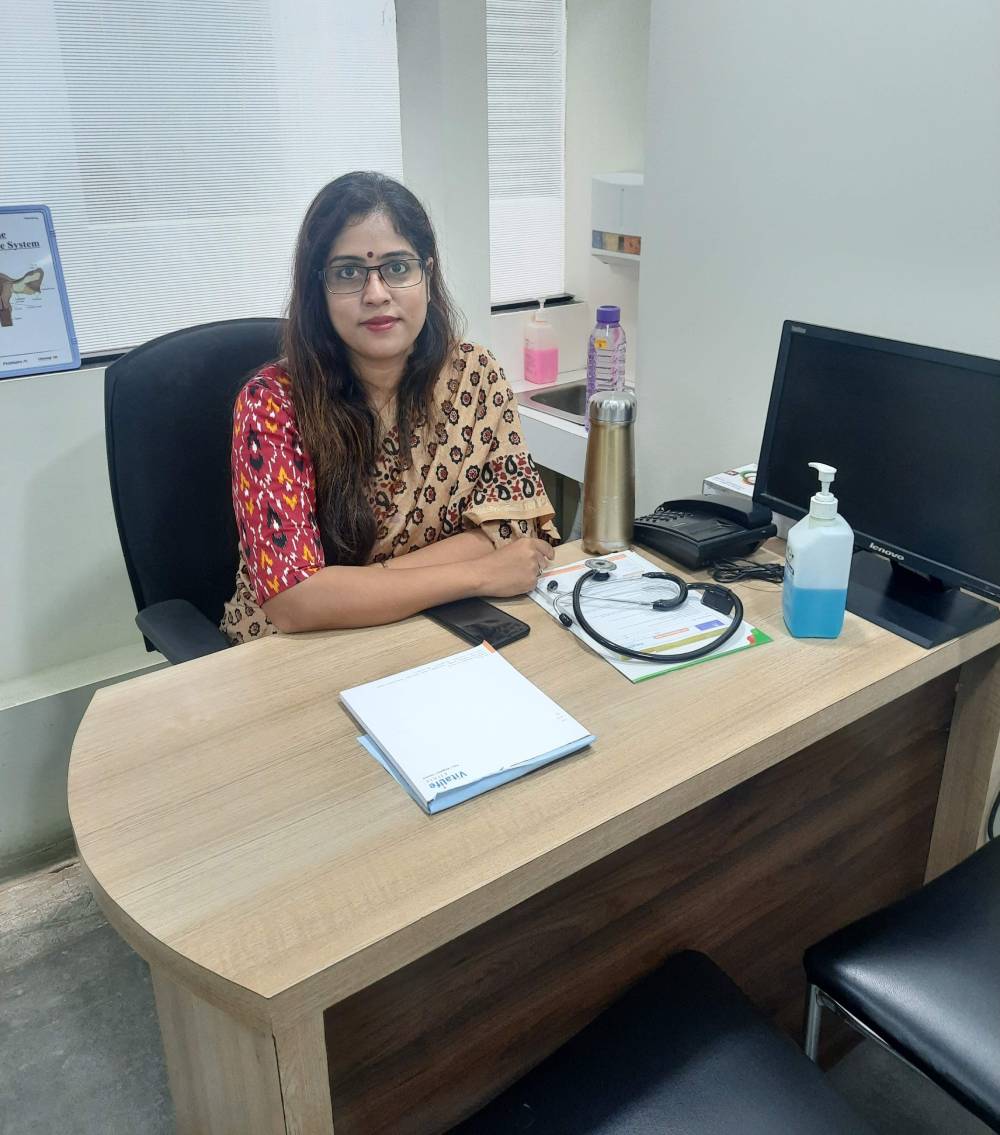Are you suffering from uterine fibroids? Looking for expert treatment? Looking For Fibroids Treatment in Pune? You’re at the right place.
Dr. Shraddha Galgali is a leading and qualified gynecologist in Punwale, PCMC, Pune, specializing in treating various gynecological conditions and performing surgeries. she is also provide Fibroids Treatment in Pune.
Dr. Shraddha Galgali is an experienced female gynecologist in Wakad Pune who can provide Uterine fibroid surgery and further tratment.
What are uterine fibroids?
Uterine fibroids, or myomas or leiomyomas, are non-cancerous tumours that develop in or on the walls of the uterus. They are the most common gynaecological tumour, affecting many women of reproductive age. Fibroids can be in size from a small seed to a large melon.
Uterine fibroids can cause pain and excessive, irregular vaginal flow, among other symptoms. A person may have no signs and be unaware of fibroids. The signs usually determine therapy for fibroids.
Where do fibroids grow?
Fibroids can begin inside or on the uterine walls. Fibroids can happen as a solitary knob or as bunches. The size can go from 1 mm to 20 centimeters (8 inches) or more.
In specific cases, fibroids can turn out to be huge to the point that they extend the uterus, giving the presence of critical weight gain or a pregnancy-like stomach. A few fibroids in the submucosa or subserosa might be pedunculated. It means they are suspended from a stalk inside or outside the uterus.
What are the different types of fibroids?
Dr. Shraddha Galgali said various kinds of fibroids exist, each with different growth patterns. While some fibroids enlarge within the uterus, others form around it. Here are some common types:
- Intramural fibroids: These are common among women and grow within the muscular walls of the uterus. They can become large and stretch the womb, causing concern despite their common occurrence.
- Subserosal fibroids: These typically grow outside the uterus, referred to as serosa. They can grow quite large, causing the womb to appear greatly enlarged, especially on one side. Though not usually critical, it’s advisable to seek advice from Dr. Shraddha Galgali.
- Submucosal fibroids: These grow within the middle muscle layer or myometrium of the uterus. However, they are less typical compared to other types of fibroids.
Are fibroids common?
Yes, fibroids are very common. The prevalence of fibroids varies among different people, but it’s calculated that up to 70-80% of women will develop fibroids at some point. However, 99% of fibroids are benign, meaning they are not cancerous. Fibroids can lead to effects such as excessive bleeding and reproductive issues.
What are the Causes of fibroids?
The reasons for fibroids are not surely known. Nonetheless, various variables add to their development, including:
- Hormones: Ovaries produce chemicals like progesterone and estrogen, which recover the uterine coating each feminine cycle and animate fibroid development.
- Family record: Fibroids are frequently hereditary. If your mom, sister, or grandma had fibroids, you are bound to foster them as well.
- Pregnancy: Pregnancy raises levels of estrogen and progesterone, improving the chance of creating fibroids during this period.
What are the symptoms of fibroids?
Dr. Shraddha Galgali explains some of the symptoms of fibroids:
- Heavy bleeding with blood clots during and after your periods
- Lower back pain or pelvic pain is yet another sign of fibroids
- Frequent urination
- Longer menstruation cycles
- Pain at the time of intercourse
- Swelling as well as growth in the abdomen.
How are uterine fibroids diagnosed?
A routine pelvic exam typically identifies uterine fibroids. However, if the fibroids are small or deeply embedded in the uterus, they might not be felt during the exam. In such instances, imaging tests may be needed to diagnose fibroids.
- Pelvic ultrasound: This is the most generally used imaging technique for diagnosing fibroids. It delivers images of the uterus and fibroids using sound waves, allowing for measures of their size and location.
- Saline infusion sonography (SIS): This test uses a transvaginal ultrasound test implanted into the vagina. A modest quantity of saline collection is infused into the uterus to improve the clearness of the ultrasound picture, assisting with imagining fibroids profound inside the uterus.
- Magnetic resonance imaging (MRI): This detailed imaging test provides data about the size, location, and structure of fibroids. MRI can also assess the blood supply to fibroids, aiding in therapy planning.
- Hysterosalpingography (HSG): This test examines the structure of the uterus and fallopian tubes by injecting a different dye into the uterus through the cervix. The dye is visible on an X-ray, helping to identify abnormalities like fibroids.
- Hysteroscopy: This procedure involves inserting a thin, lighted instrument called a hysteroscope into the uterus through the cervix. It allows the gynecologist to directly view the inside of the uterus and any fibroids present.
What are the treatments for fibroids?
At Dr. Shraddha’s EXCELLA Woman’s Wellness Clinic, our experts curate personalized therapies depending on the severity of the signs, the size and location of the fibroids, and whether or not you desire to have children in the future.
Common treatment strategies used by us include:
- Regular monitoring for ladies with asymptomatic fibroids and treating them if signs emerge or worsen.
- Medicines like birth control pills, progestin-releasing intrauterine devices (IUDs), and gonadotropin-releasing hormone (GnRH) agonists, to shrink fibroids and reduce pain.
- Surgery may be required if fibroids are causing serious signs or interfering with fertility. There are several surgical choices available, including:
- Myomectomy: A surgical technique that removes fibroids while leaving the uterus intact, making it an option for women who want to have children in the future.
- Hysterectomy: A surgical operation to remove the uterus that provides a permanent solution to fibroids but is not an option for women who want to have children in the future.
- Uterine fibroid embolization (UFE): It is a procedure used to treat Uterine Fibroids. An insignificantly intrusive therapy includes infusing minuscule particles into the blood conduits that supply blood to the fibroids, making them psychologist and passed on.
When to see the Dr. Shraddha Galgali?
You should meet Dr. Shraddha Galgali is the best Laparoscopic Surgery in Punawale, Pune for uterine fibroids if you are experiencing any of the following signs:
- Heavy menstrual bleeding
- Painful menstrual cramps
- Pelvic pressure or pain
- Frequent urination
- Constipation
- Problem getting pregnant
Can fibroids be prevented?
There is no known way to prevent uterine fibroids, but women can reduce their risk by:
- Maintaining a healthy weight
- Eating a balanced diet rich in fruits, vegetables, and whole grains
- Keep Exercising regularly
- Stop smoking
- Getting normal clinical tests, including pelvic tests, to screen for fibroids and other gynecological issues.
Book An Appointment:
Overall, Dr. Shraddha’s EXCELLA Woman’s Wellness Clinic in Punawale, Pune is the best choice for Fibroid Removal Specialist treatment in the area. With their trained staff, modern equipment, and dedication to quality care, patients can rest assured that they are in good hands. Whether you’re located in Wakad, Hinjewadi or nearby, Dr. Shraddha Galgali offers Infertility Treatment in Punawale, Pune and she is the right choice for your fertility needs.
Feel free to call us on 9923956515 for appointments and queries or book an online appointment.

